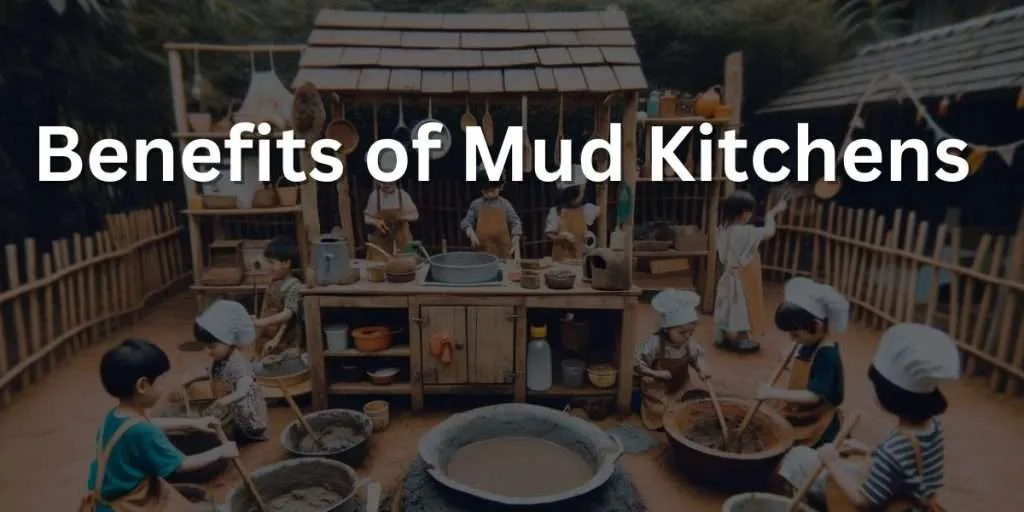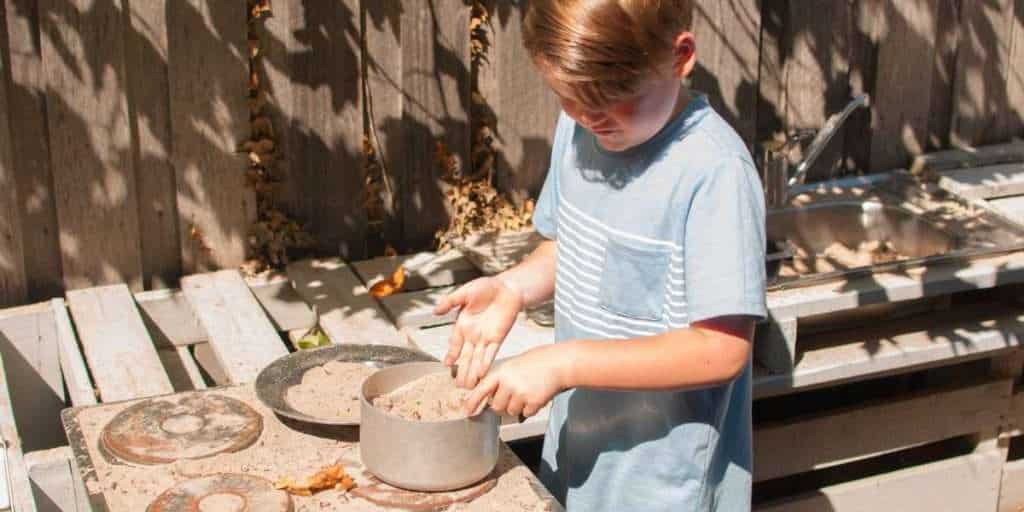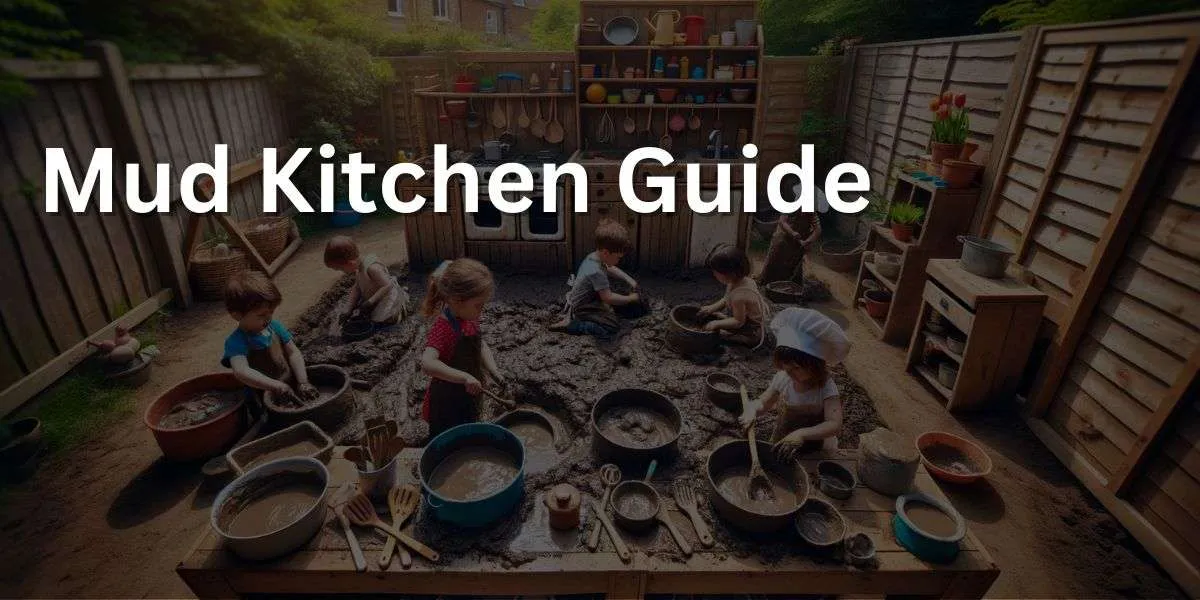This Mud Kitchen Guide serves as your blueprint to creating an al fresco play space where children can stir up not just mud pies, but also a feast of learning opportunities.
These whimsical outdoor play setups invite young ones to dive hands-first into the world of imaginative cooking, all while connecting with nature. But mud kitchens are more than just child’s play; they’re an avenue for sensory development, creativity, and unstructured fun.
Journey with us as we delve into the magic of mud kitchens, exploring their benefits, construction, and the endless possibilities they offer. Ready to cook up some muddy memories?
Key Takeaways : Mud Kitchens
- Sensory development: Mud kitchens provide a rich sensory experience, allowing children to touch, smell, and see the natural elements. Playing with mud can help refine motor skills and enhance tactile sensitivity.
- Creativity and imagination: Children can pretend to “cook,” create recipes, and serve “meals,” fostering imaginative play and encouraging creativity.
- Learning about nature: Mud kitchens can introduce children to natural materials, like leaves, twigs, and stones, deepening their understanding and appreciation of the environment.
- Social skills: Collaborative play in mud kitchens helps develop social skills, such as sharing, negotiation, and teamwork. Children learn to communicate, plan together, and resolve conflicts.
- Cognitive development: Mud play can enhance cognitive skills as children experiment, problem-solve, and make connections between cause and effect.
- Enhanced concentration: The hands-on nature of mud play can boost concentration and focus. Children often become deeply engaged in their activities, refining their attention spans.
- Physical development: Mud kitchen play promotes physical activity, including scooping, pouring, stirring, and molding, which helps develop fine and gross motor skills.
- Safe risk-taking: Mud kitchens offer a controlled environment for children to explore risks, like getting dirty or trying new textures, fostering resilience and adaptability.
- Emotional well-being: Playing in a mud kitchen can be therapeutic. The sensory experience of mud can be calming, reducing stress and anxiety in children.
- Economic and sustainable: Mud kitchens can be made using recycled or upcycled materials, making them an affordable and eco-friendly play option.
What is a mud kitchen?
A mud kitchen is an outside toy kitchen that allows children to combine the joy and benefits of role play with all the sensory delights of mixing up mud. Mud kitchens, also known as outdoor play kitchens or nature kitchens, are a popular resource in early childhood education settings. They offer children a tactile and imaginative experience in an outdoor environment
What is a mud kitchen? it’s whatever you need it to be! Kids love playing in the water and mud and there’s nothing better than mixing up a mud pie, making mud cakes or stirring a pot of mud soup to get the creative juices flowing and engage the senses. Mud kitchens are growing in popularity and tend to be especially popular amongst boys. Kids just love a play in the mud.
Mud kitchens are a great way to encourage children out to the garden and represents play at it’s most natural: do children like anything more than playing in the dirt?
With an outdoor kitchen, your have so many more opportunities for sensory experience; use natural items such as stone, wood and water to introduce a wide range of different textures.
There are no limits to the imaginative play possibilities, and many parents prefer to to have a mud kitchen in the outdoor environment so they don’t have to sacrifice indoor space or worry as much about mess.
Playing in an outside toy kitchen allows children to explore nature and get messy in a way they can’t do while playing indoors. And while mud kitchens are obviously great during the warmer months they are also a great way to encourage children to play outside in winter providing you have a good set of waterproofs.

Benefits of Mud Kitchens
Mud kitchens offer rich benefits, tapping into the psychology of play, which underscores their value in child development.
Children engage with natural elements, which fosters sensory development. The texture of mud, the fluidity of water, and the variety of found objects used in play stimulate the senses.
Creative expression thrives in mud kitchens. Children concoct mud recipes and scenarios, cultivating imagination and symbolic thought, key in cognitive development.
Social skills simmer in these earthy play spaces. Peers collaborate, negotiate roles, and share tools, cooking up teamwork and communication skills.
Problem-solving is another dish served by mud kitchens. Children face tasks like measuring water or balancing mud pies, which enhance their analytical skills.
Mud kitchens respect the intrinsic motivations of play, allowing children autonomy, mastery, and purpose, which psychologists highlight as essential for intrinsic motivation and learning.
Physical development is kneaded into play as children scoop, pour, and mix, which improves fine motor skills and hand-eye coordination.
Emotionally, mud kitchens are a haven for stress relief and resilience building. Children learn through trial and error in a low-stakes environment, which bolsters their confidence and emotional intelligence.
Mud Kitchens and Sensory Play
Mud kitchens excel as platforms for sensory play, engaging children in experiences that stimulate their senses and support cognitive growth.
The tactile sensations of mud vary from wet to dry, offering a rich tactile experience. Children feel the mud squish through their fingers, an activity that promotes tactile awareness and descriptive vocabulary development.
Visual stimulation is present as children observe the color changes and form shapes with mud. The shifting hues and textures in play support visual processing and creativity.
The olfactory sense is enlivened by the earthy scents of soil and water. This olfactory engagement aids in memory formation and the association of smells with experiences.
Auditory senses are also involved as children listen to the sounds of splashing water and squelching mud, which can be calming and provide auditory feedback on their actions.
Taste, while not directly involved, is indirectly engaged through imaginative play, as children pretend to taste their mud pies, fostering imagination and symbolic play.
Proprioceptive and vestibular inputs are integrated as children carry water, stir mixtures, and balance themselves in uneven play areas, which enhances their physical coordination and spatial awareness.
Mud kitchens offer a multisensory experience that underpins the development of sensory integration, a process vital for learning and behavior. These kitchens are a feast for the senses, nurturing children’s development in a playful and dynamic environment.
Mud Kitchens and Fine Motor Skills Development
Mud kitchens serve as a delightful workshop for honing fine motor skills, pivotal in the intricate dance of hand and finger movements.
Children scoop and shape mud, actions that refine hand-eye coordination and dexterity. This manipulation of materials requires precision, fostering the development of grip and control.
Utensils in mud kitchens, like spoons and whisks, become tools for transformation, where children practice the motions of stirring and pouring. Through these activities, they gain wrist agility and learn the nuances of pressure application.
Molding mud into imaginative shapes and forms nurtures creativity while also demanding delicate finger movements. This creative expression is tightly linked to fine motor skill advancement.
The opening and closing of containers challenge children with tasks that require a gentle touch and an understanding of force. Mastery of these tasks is essential for daily self-care skills.
Mud kitchens offer a sandbox of opportunities for children to experiment with and develop their fine motor skills. The joyous blend of play and learning in these kitchens lays the foundation for academic tasks such as writing and cutting with scissors, making mud play not just fun, but functionally significant.
Mud Kitchens and Creativity Boost
Mud kitchens act as a catalyst for creativity, providing a canvas where imagination flourishes.
Children engage with elements like water, soil, and sand, which serve as raw materials for their inventive concoctions. This engagement promotes imaginative play, where mud pies and sandcakes are not just treats but a feast for creativity.
Role-playing within mud kitchens allows children to experiment with diverse scenarios, each narrative enhancing their creative thought processes. They become chefs, scientists, or explorers, roles that encourage original thinking and problem-solving.
The open-ended nature of mud kitchen activities ensures that no two play sessions are alike. This variety challenges children to invent new recipes and stories, thus boosting their creative faculties.
In this alchemy of play, children mix, pour, and decorate, activities that parallel the creative acts of painting and sculpting. Through such processes, they learn the art of creation, transforming simple materials into imaginative masterpieces.
Mud kitchens, therefore, are not just playful spaces but incubators for creativity, where every child can stir up their own blend of innovation and artistry.
Mud Kitchens and Encouraging Outdoor Play
Mud kitchens entice children into the outdoors, offering an interactive playground that merges nature with play.
The setup of mud kitchens naturally occurs in an outdoor environment, where the elements—earth, water, air—are at a child’s fingertips. This context anchors children in an outdoor setting, promoting engagement with the natural world.
Children interact with various textures and materials found outside, from leaves and sticks to pebbles and dirt. This interaction is sensory play that not only entertains but also educates about the environment.
Outdoor play, facilitated by mud kitchens, encourages physical activity. Kids scoop, stir, and pour, actions that develop gross motor skills and overall physical health.
The social aspect of mud kitchens fosters cooperative play. As children gather in these outdoor settings, they learn to share space and materials, negotiate roles, and collaborate on culinary creations.
In essence, mud kitchens serve as a bridge, connecting the joy of indoor play with the vast possibilities of the outdoors. They champion the cause of outdoor play by providing an appealing and adventurous platform for children to explore and enjoy.
Essential Mud Kitchen Accessories

Furnishing your mud kitchen with necessary accessories can provide unending fun and learning opportunities for your child. We will explore indispensable items like:
- Mixing bowls
- Old pots and pans
- Wooden spoons
- Storage space
Mixing bowls are a great way to encourage your child to explore different textures and ingredients.
Mixing Bowls
Any mud kitchen would be incomplete without mixing bowls. They come in various sizes and materials, from plastic to stainless steel, and can be used for a variety of activities such as mixing mud, creating potions, or even holding water for cleaning up.
Be sure to have a good assortment of mixing bowls on hand to keep your child engaged and inspired during their mud kitchen play.
Old Pots and Pans
Instead of discarding old pots and pans, consider repurposing them for your child’s mud kitchen. Old pots and pans are perfect for outdoor play as they can withstand rough handling and weather conditions.
They also provide a great opportunity for children to learn about different cooking methods and techniques as they experiment with their mud concoctions.
Wooden Spoons
For stirring and mixing in your mud kitchen, wooden spoons are a versatile and sustainable choice. They are gentle on cookware and provide a firm handle for effective stirring. Plus, wooden spoons are a natural material that is easy to clean and maintain.
Be sure to have a variety of wooden spoons on hand to encourage your child to explore different mixing techniques and enhance their play.
Storage Space
To ensure accessories remain organized and within reach, sufficient storage space is indispensable in any mud kitchen. Consider adding shelves, hooks, or even repurposed cupboards to provide ample space for pots, pans, utensils, and other mud kitchen necessities.
By keeping the mud kitchen tidy and organized, children can focus on their play and easily find the tools they need to create their masterpieces.
Mud Kitchen Play Ideas and Activities

With your mud kitchen now set up, we can delve into some thrilling play ideas and activities. In this section, we will discuss making mud pies, creating nature-inspired recipes, and conducting potion experiments.
These activities not only provide endless fun but also promote learning and exploration.
Making Mud Pies
The time-honored and much-loved activity of making mud pies in the mud kitchen provides an opportunity for children to delve into texture exploration and concoct imaginative mixtures. To make mud pies, simply mix mud and water in a bowl, then use kitchen utensils to shape the mud into pies.
Encourage your child to experiment with different textures and add natural items like leaves, flowers, and sticks as decorations. This hands-on activity promotes creativity and sensory exploration while providing hours of messy fun.
Nature-Inspired Recipes
Children can use natural materials such as leaves, flowers, and herbs in their mud kitchen play through nature-inspired recipes. For example, they can create a “flower soup” by adding petals and leaves to a bowl of water, or make a “herb salad” by mixing different types of herbs with mud.
Encourage your child to use their imagination and create their own unique recipes using materials found in nature. This activity not only fosters creativity but also helps children develop an appreciation for the natural world around them.
Potion Experiments
Potion experiments lend a magical and scientific element to mud kitchen play. Children can mix various ingredients to create fizzing, colorful, and even glittery potions. Some ingredients to try include:
- Baking soda
- Vinegar
- Food coloring
- Glitter
Encourage your child to experiment with different combinations and observe the reactions that occur.
This activity not only promotes scientific exploration and creativity but also helps children develop problem-solving and critical thinking skills.
Expanding Your Mud Kitchen
Ready to elevate your mud kitchen? Think about extending it by incorporating a herb garden, seating area, or water play station. These additions not only provide more opportunities for play and learning but also enhance the overall mud kitchen experience.
Adding a herb garden to your mud kitchen can provide a sensory experience for children as they explore
Herb Garden
Introducing a herb garden to your mud kitchen offers extra sensory experiences and learning opportunities about plants and gardening. Children can plant, care for, and harvest herbs such as rosemary, thyme, chives, parsley, sage, and mint. They can then incorporate these herbs into their mud kitchen play, creating aromatic and flavorful concoctions.
A herb garden not only adds a touch of greenery to your outdoor play area but also teaches children about plant life cycles and the importance of caring for the environment.
Seating Area
Establishing a seating area gives children a space to unwind, interact, and relish their mud kitchen creations. Choose a cozy spot, add comfortable benches or chairs, and consider adding plants and flowers to create a pleasant atmosphere.
A seating area not only provides a place for children to rest and recharge but also encourages social interaction and communication skills.
Water Play Station
Incorporating a water play station introduces an additional aspect of fun and discovery to the mud kitchen experience. Incorporate a water table or container next to the mud kitchen for water play activities such as pouring, scooping, and mixing. Water play promotes sensory exploration and scientific inquiry while also providing a refreshing break from mud play on hot summer days.
Children can use cups, spoons, and other kitchen utensils to explore the properties
Frequently Asked Questions About Mud Kitchens
Are mud kitchens worth it?
Mud Kitchens are an ideal way to create an exciting and educational outdoor space for children, as they don’t require a lot of space and encourage creative play! They’re definitely worth it.
How much does it cost to build a mud kitchen?
It’s easy and cost effective to build a kid sized mud kitchen using $200 in materials from your local hardware store – making it an essential backyard toy for kids ages 3 and up!
Why is it called a mud kitchen?
The name ‘mud kitchen’ perfectly captures its purpose; it’s an outdoor kitchen for kids to have fun with mud, create their own recipes, and use old pots, pans, spoons, and buckets to bring their imaginings to life.
What age should you buy a mud kitchen?
Kids between the ages of 1 and 7 will get the most out of a mud kitchen, but it can also bring joy to older children too! Mud kitchens offer a great way for kids to engage in sensory play while also developing important academic skills such as literacy and numeracy.
What is a muddy kitchen?
A mud kitchen is an outdoor structure for play and creativity, where children can pretend to cook using mud, sand, water, and tools. It includes a surface to work, a sink or bin area, as well as shelves, bowls, mud, and other tools – all coming together to let kids create a make-believe kitchen experience! Mud kitchens are a great way to encourage imaginative play and help children develop their fine motor skills. They can also be used to teach children about the environment, as they learn to use natural materials to create something new.





